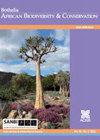Distribution of Mimosa diplotricha in eastern and southern Africa and its socioecological impacts in northern Malawi
IF 0.5
4区 生物学
Q4 PLANT SCIENCES
引用次数: 1
Abstract
Background: Mimosa diplotricha is an emerging or established weed in many parts of the world, including many countries in Africa, where it is impacting on biodiversity, crop and pasture production, and driving socio-ecological change. Objectives: To establish the current distribution of M. diplotricha in eastern and southern Africa and its impacts on livelihoods in northern Malawi. Methods: Records on current distribution were collected from roadside surveys, literature reviews and herbarium data. Household surveys were conducted in the Karonga District, Malawi, to understand its impacts on local livelihoods. Results: Mimosa diplotricha is abundant in western Ethiopia, southern Tanzania, and northern and southeastern Malawi with isolated populations in western Rwanda, Burundi, Mozambique, and on the northern shores of Lake Victoria in Uganda. Most respondents said that M. diplotricha invasions were reducing the amount of grass and shrubs in rangelands, with over half saying it reduced crop yields. This invasive plant is also reducing the availability of medicinal plants and other natural resources. Conclusions: Mimosa diplotricha has the potential to significantly expand its range in eastern Africa, and parts of southern Africa, and as such there is an urgent need to develop and implement an integrated management strategy, including biological control, to reduce the negative effects of this invasive plant on local livelihoods.含羞草在非洲东部和南部的分布及其对马拉维北部的社会生态影响
含羞草(Mimosa diplotricha)是一种新兴或成熟的杂草,在世界许多地方,包括非洲的许多国家,它正在影响生物多样性、作物和牧场生产,并推动社会生态变化。目的:确定非洲东部和南部白僵菌的分布现状及其对马拉维北部生计的影响。方法:通过路边调查、文献查阅、植物标本室资料等收集现状分布记录。在马拉维karonga区进行了住户调查,以了解其对当地生计的影响。结果:Mimosa diplotricha在埃塞俄比亚西部、坦桑尼亚南部、马拉维北部和东南部分布丰富,在卢旺达西部、布隆迪、莫桑比克和乌干达维多利亚湖北岸有孤立种群。大多数受访者表示,白桦尺蠖的入侵减少了牧场草地和灌木的数量,超过一半的受访者表示它减少了农作物产量。这种入侵植物也减少了药用植物和其他自然资源的可用性。结论:含羞草(Mimosa diplotricha)有可能在非洲东部和南部部分地区显著扩大其分布范围,因此迫切需要制定和实施包括生物防治在内的综合管理策略,以减少这种入侵植物对当地生计的负面影响。
本文章由计算机程序翻译,如有差异,请以英文原文为准。
求助全文
约1分钟内获得全文
求助全文
来源期刊

Bothalia
生物-植物科学
CiteScore
1.70
自引率
0.00%
发文量
12
期刊介绍:
Bothalia: African Biodiversity & Conservation is published by AOSIS for the South African National Biodiversity Institute (SANBI) and aims to disseminate knowledge, information and innovative approaches that promote and enhance the wise use and management of biodiversity in order to sustain the systems and species that support and benefit the people of Africa.
The journal was previously published as Bothalia, and had served the South African botanical community since 1921. However the expanded mandate of SANBI necessitated a broader scope for the journal, and in 2014, the subtitle, African Biodiversity & Conservation was added to reflect this change.
 求助内容:
求助内容: 应助结果提醒方式:
应助结果提醒方式:


